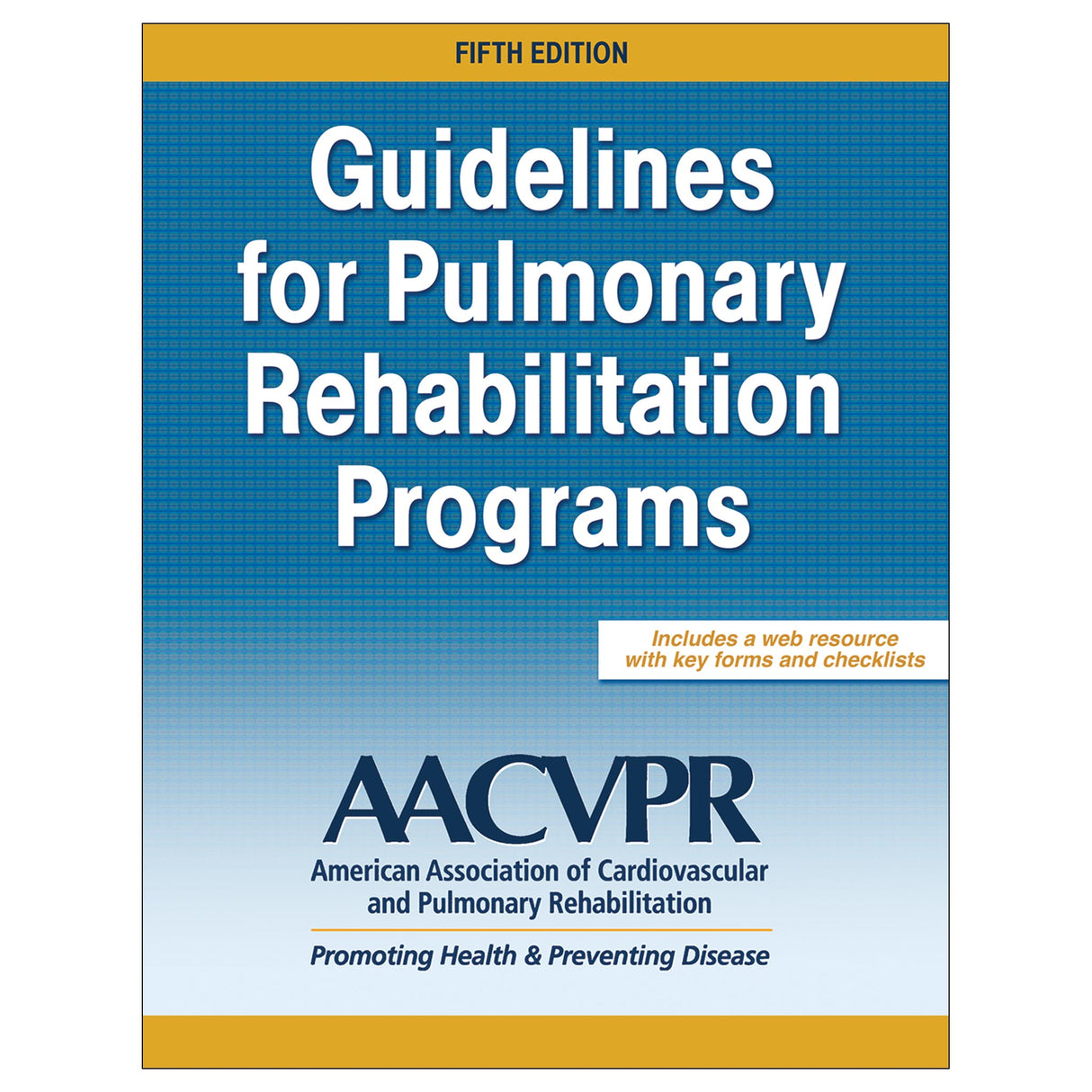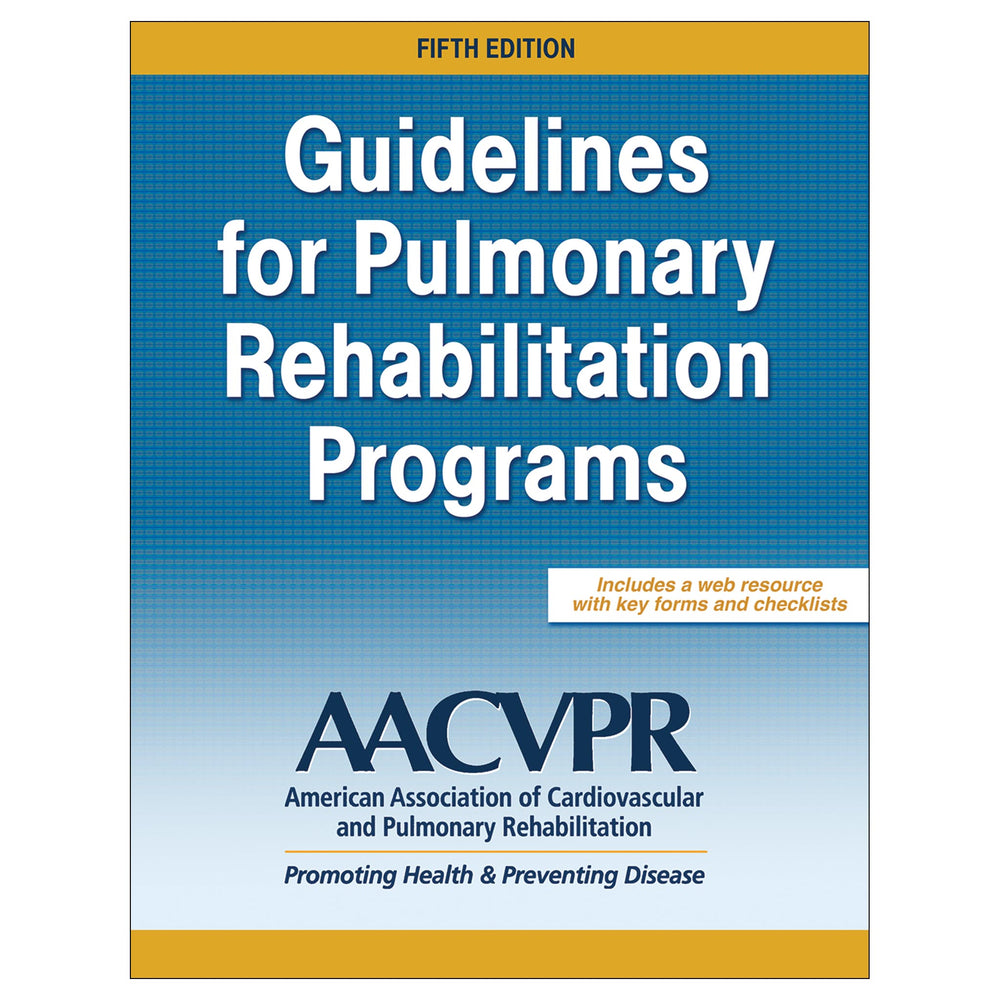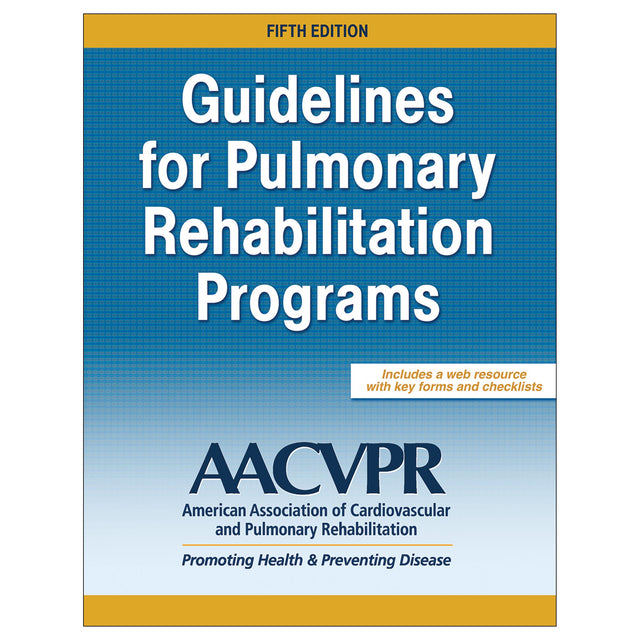Ebook With Online Resource
Guidelines for Pulmonary Rehabilitation Programs 5th Edition epub With Web Resource
Author: AACVPR
$93.95 CAD
Unit price
/
Unavailable
Ebook With Online Resource
$93.95 CAD
$93.95 CAD
Access Duration: 10 Years
Ebook With Online Resource
As the field of pulmonary rehabilitation has continued to advance and evolve, standards for patient care and for programs have become increasingly important. Guidelines for Pulmonary Rehabilitation Programs, Fifth Edition With Web Resource, offers the best practices for patient care and serves as the must-have resource for programs to prepare for the American Association of Cardiovascular and Pulmonary Rehabilitation (AACVPR) pulmonary rehabilitation program certification. Readers will learn to tailor individualized care for respiratory patients as well as to improve new programs or update existing programs.
For this revised fifth edition, AACVPR has assembled an expert team of nationally and internationally recognized authors. Together, they present the individuated and interrelated components of pulmonary rehabilitation, including initial and ongoing assessment, collaborative self-management education, exercise training, psychosocial support, and outcome measurement. Highlighted guidelines have been included throughout the book, giving readers easy-to-find guidance for implementing treatment programs and helping patients stay on track.
Guidelines for Pulmonary Rehabilitation Programs, Fifth Edition With Web Resource, offers an evidence-based review in several areas based on the rapid expansion of high-quality scientific evidence since the last edition. To learn best practices for care and program development, readers will find contributions from expert pulmonary rehabilitation professionals in nursing, medicine, physical therapy, respiratory therapy, and exercise physiology. This text provides a scientific, practical framework to help aspiring and current practitioners do the following:
With continued advancements in the science, application, and credentialing of pulmonary rehabilitation programs, the fifth edition of Guidelines for Pulmonary Rehabilitation Programs will assist respiratory practitioners in remaining up to date on the best practices in the field. This edition supports practitioners in understanding the components of pulmonary rehabilitation and applying best practices as well as updating and improving their programs to meet AACVPR certification requirements.
For this revised fifth edition, AACVPR has assembled an expert team of nationally and internationally recognized authors. Together, they present the individuated and interrelated components of pulmonary rehabilitation, including initial and ongoing assessment, collaborative self-management education, exercise training, psychosocial support, and outcome measurement. Highlighted guidelines have been included throughout the book, giving readers easy-to-find guidance for implementing treatment programs and helping patients stay on track.
Guidelines for Pulmonary Rehabilitation Programs, Fifth Edition With Web Resource, offers an evidence-based review in several areas based on the rapid expansion of high-quality scientific evidence since the last edition. To learn best practices for care and program development, readers will find contributions from expert pulmonary rehabilitation professionals in nursing, medicine, physical therapy, respiratory therapy, and exercise physiology. This text provides a scientific, practical framework to help aspiring and current practitioners do the following:
- Understand the current requirements for accrediting pulmonary-based facilities
- Design, implement, or update accredited pulmonary rehabilitation programs
- Deliver optimal care to patients with symptomatic respiratory needs
- Address program issues in exercise, outcomes, and management of pulmonary-based programs
With continued advancements in the science, application, and credentialing of pulmonary rehabilitation programs, the fifth edition of Guidelines for Pulmonary Rehabilitation Programs will assist respiratory practitioners in remaining up to date on the best practices in the field. This edition supports practitioners in understanding the components of pulmonary rehabilitation and applying best practices as well as updating and improving their programs to meet AACVPR certification requirements.
Audience
A certification guide and program development tool for AACVPR member pulmonary rehabilitation departments as well as specialists, nonaffiliated pulmonary rehabilitation specialists, and pulmonary program directors. Chapter 1. Overview of Pulmonary Rehabilitation
Brian Carlin
Definition
Rationale for Pulmonary Rehabilitation
Pulmonary Rehabilitation and Integrated Care of the Respiratory Patient
History of Pulmonary Rehabilitation
Evidence-Based Guidelines on Pulmonary Rehabilitation
Positioning Pulmonary Rehabilitation within the GOLD 2017 Guidelines
Current Status of Pulmonary Rehabilitation
Summary
Chapter 2. Selecting and Assessing the Pulmonary Rehabilitation Candidate
Gerilynn Connors and James Lamberti
Patient Selection
Patient Assessment
Summary
Chapter 3. Exercise Assessment and Training
Chris Garvey, Rebecca Crouch, and Dave Verrill
Rationale for Exercise Training in Chronic Lung Disease
Mechanisms of Exercise Intolerance in Chronic Respiratory Disease
Exercise Assessment
Field Tests (Walking Tests)
Graded Exercise Test and Cardiopulmonary Exercise Tests
Functional Performance Assessment
Exercise Prescription
Volume, Pattern, and Progression of Exercise Training
Resistance Exercise Testing
Other Tests of Muscular Fitness
Inspiratory Muscle Training
Flexibility Training
Patient Safety
Precautions in Pulmonary Hypertension
Exercise Induced Hypoxemia
Home Exercise Considerations
Emergency Procedures
Documentation of the Evaluation and Treatment Session
Summary
Chapter 4. Collaborative Self-Management and Education
Gerene Bauldoff, Jane Knipper, and Debbie Koehl
Developing an Individualized Self-Management Program
Implementing Self Management Training
Summary
Chapter 5. Psychosocial Assessment and Intervention
Maria Buckley and Kent Eichenauer
Assessment of Psychosocial Functioning
Interventions to Improve Psychosocial Functioning
Partnering with a Psychosocial Provider
Summary
Chapter 6. Nutritional Assessment and Intervention
Ellen Aberegg
Compromised Nutritional Status in Pulmonary Disease
Diet Intake and COPD
Assessment of Nutritional Status
Nutrition Support
Summary
Chapter 7. Patient-Centered Evidence-Based Outcomes
Gerene Bauldoff and Eileen Collins
Timing and Analyzing Outcomes
Patient-Centered Outcome Measures
Summary
Chapter 8. Disease-Specific Approaches to Pulmonary Rehabilitation
Charlotte Tenebeck, Katherine Mensons, Jonathan Raskin, and Brian Carlin
Restrictive Lung Diseases
Pulmonary Hypertension
Other Pulmonary Rehabilitation Populations
Summary
Chapter 9. Program Management and Reimbursement Realities
Trina Limberg, June Schulz, and Karen Lui
Interdisciplinary Team
Program Content and Structure
Administrative Aspects of Program Management
Postrehabilitation Maintenance
Reimbursement Realities
Strategies for Program Success
Summary
Chapter 10. Putting It All Together: Performance Measures, Outcomes, Valid and Reliable Tools, and Program Certification
Anne Gavic and Steve Lichtman
Measuring the Quality of Patient Care
AACVPR Outpatient Pulmonary Rehabilitation Registry
Pulmonary Rehabilitation Certification
Summary
Appendix A: Forms, Questionnaires, Assessments, and Individualized Treatment Plan Example
Appendix B: Excerpt from ATS/ERS Statement: Key Concepts and Advancements in Pulmonary Rehabilitation
Appendix C: Clinical Competency Guidelines for Pulmonary Rehabilitation Professionals
Appendix D: Example of Typical Pulmonary Rehabilitation Facility and Program Schedules
Appendix E: Summary of Additional Recommended Guidelines for Pulmonary Rehabilitation
Brian Carlin
Definition
Rationale for Pulmonary Rehabilitation
Pulmonary Rehabilitation and Integrated Care of the Respiratory Patient
History of Pulmonary Rehabilitation
Evidence-Based Guidelines on Pulmonary Rehabilitation
Positioning Pulmonary Rehabilitation within the GOLD 2017 Guidelines
Current Status of Pulmonary Rehabilitation
Summary
Chapter 2. Selecting and Assessing the Pulmonary Rehabilitation Candidate
Gerilynn Connors and James Lamberti
Patient Selection
Patient Assessment
Summary
Chapter 3. Exercise Assessment and Training
Chris Garvey, Rebecca Crouch, and Dave Verrill
Rationale for Exercise Training in Chronic Lung Disease
Mechanisms of Exercise Intolerance in Chronic Respiratory Disease
Exercise Assessment
Field Tests (Walking Tests)
Graded Exercise Test and Cardiopulmonary Exercise Tests
Functional Performance Assessment
Exercise Prescription
Volume, Pattern, and Progression of Exercise Training
Resistance Exercise Testing
Other Tests of Muscular Fitness
Inspiratory Muscle Training
Flexibility Training
Patient Safety
Precautions in Pulmonary Hypertension
Exercise Induced Hypoxemia
Home Exercise Considerations
Emergency Procedures
Documentation of the Evaluation and Treatment Session
Summary
Chapter 4. Collaborative Self-Management and Education
Gerene Bauldoff, Jane Knipper, and Debbie Koehl
Developing an Individualized Self-Management Program
Implementing Self Management Training
Summary
Chapter 5. Psychosocial Assessment and Intervention
Maria Buckley and Kent Eichenauer
Assessment of Psychosocial Functioning
Interventions to Improve Psychosocial Functioning
Partnering with a Psychosocial Provider
Summary
Chapter 6. Nutritional Assessment and Intervention
Ellen Aberegg
Compromised Nutritional Status in Pulmonary Disease
Diet Intake and COPD
Assessment of Nutritional Status
Nutrition Support
Summary
Chapter 7. Patient-Centered Evidence-Based Outcomes
Gerene Bauldoff and Eileen Collins
Timing and Analyzing Outcomes
Patient-Centered Outcome Measures
Summary
Chapter 8. Disease-Specific Approaches to Pulmonary Rehabilitation
Charlotte Tenebeck, Katherine Mensons, Jonathan Raskin, and Brian Carlin
Restrictive Lung Diseases
Pulmonary Hypertension
Other Pulmonary Rehabilitation Populations
Summary
Chapter 9. Program Management and Reimbursement Realities
Trina Limberg, June Schulz, and Karen Lui
Interdisciplinary Team
Program Content and Structure
Administrative Aspects of Program Management
Postrehabilitation Maintenance
Reimbursement Realities
Strategies for Program Success
Summary
Chapter 10. Putting It All Together: Performance Measures, Outcomes, Valid and Reliable Tools, and Program Certification
Anne Gavic and Steve Lichtman
Measuring the Quality of Patient Care
AACVPR Outpatient Pulmonary Rehabilitation Registry
Pulmonary Rehabilitation Certification
Summary
Appendix A: Forms, Questionnaires, Assessments, and Individualized Treatment Plan Example
Appendix B: Excerpt from ATS/ERS Statement: Key Concepts and Advancements in Pulmonary Rehabilitation
Appendix C: Clinical Competency Guidelines for Pulmonary Rehabilitation Professionals
Appendix D: Example of Typical Pulmonary Rehabilitation Facility and Program Schedules
Appendix E: Summary of Additional Recommended Guidelines for Pulmonary Rehabilitation
“This book continues to be the bible for evidence-based pulmonary rehabilitation programs.”
—Doody’s Book Review (Four-Star Review)
—Doody’s Book Review (Four-Star Review)
Assessment of nutritional status in clients with COPD
Field (walking) tests for measurement of functional capacity
Strategies to improve success in a pulmonary program
Field (walking) tests for measurement of functional capacity
Strategies to improve success in a pulmonary program
All ancillaries are free to course adopters and available online.
Web resource. Includes practical checklists and tools from the book and provides readers with biannual updates to keep them current with key changes in the field.
Web resource. Includes practical checklists and tools from the book and provides readers with biannual updates to keep them current with key changes in the field.





